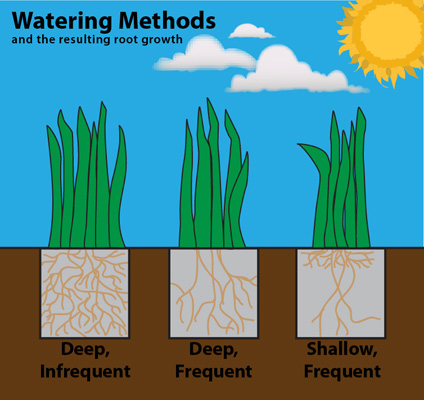Grasses
Caring for Grasses
Turfgrass
In general, we recommend reducing the amount of turf grass that you have because of the high levels of maintenance and water that lawns use. By having less turf grass, you don't have to fall into the endless cycle of fertilizing, watering, and mowing. If you wish to maintain your lawn, there are several things you can do to help reduce your water consumption and have a healthy lawn.
The following video is from the Sustainable Landscape Series from the City of Allen and covers watering, fertilizing, mowing, and pest control for lawns.
The Keys to a Green Lawn
Choose the right grass variety for your exact location. Bermuda Grass is the most common turf grass in the North Texas area because it is drought tolerant. Bermuda Grass has the ability to go dormant in a drought and come back when the rain returns. St. Augustine is not a drought tolerant grass. Zoysia is a slow growing turf with a low water requirement and will tolerate a little bit of shade. Bermuda Grass will not grow in shade, it requires full sun - at least 6 hours of direct sunlight. Even St. Augustine, which is considered a "shade tolerant" variety, requires at least 4 hours of direct sunlight a day. Grass under trees will not thrive. Grass between two houses will not typically thrive. We suggest choosing some shade tolerant shrubs or perennials, which require little to no maintenance. Buffalo grass will not fare well in an urban environment, unless you have several acres of land and want to have a zero maintenance turf, Buffalo grass will not fare well. Buffalo grass requires zero shade, doesn't fare well with foot traffic, and works best with no maintenance.
Healthy Soil - Most of the soil in North Texas is clay type soil. Clay soils hold on to water extremely well, so with proper watering techniques you will not have to water your lawn as much as you might think (less than twice per week, even in the summer). To water clay soils you need to water just a little to get ground wet, then water more to allow the soil to soak up the water. Clay soil acts like a sponge, when it is dry the water just runs off. But with little bits of water to start with and get the sponge wet, it will then be able to soak up much more water.
Do not put pesticides on your lawn. Pesticides kill between 60% and 90% of earthworms (which are crucial for soil health) where they are used. Lawn care pesticides also have the capability to kill birds and when fertilizers and pesticides run off into the street and down a storm drain, they pollute our water systems. The nutrients lead to algae buildup, depleting the dissolved oxygen content, which in turn kills fish. Our storm drains lead to a creek, which leads to a river, and then goes into a lake, which is our water supply.Have a healthy root system. Proper watering technique of deep, infrequent waterings will cause the grass to develop a deep root system that will help it sustain in periods of drought.

Ornamental Grass
Native ornamental grasses (or "bunch" grasses) require even less maintenance than turf grass. If you have ornamental grasses as accent specimens in your landscape, simply cut them back to a 6 to 8 inch mound in February. The ends of the stalks you remove will contain seeds. Scatter these seed heads wherever you'd like to encourage more of that species. You can use the remaining portions of the stalks as mulch, or compost them.
Leave it on the lawn! Yard clippings can pollute nearby streams and creeks.
